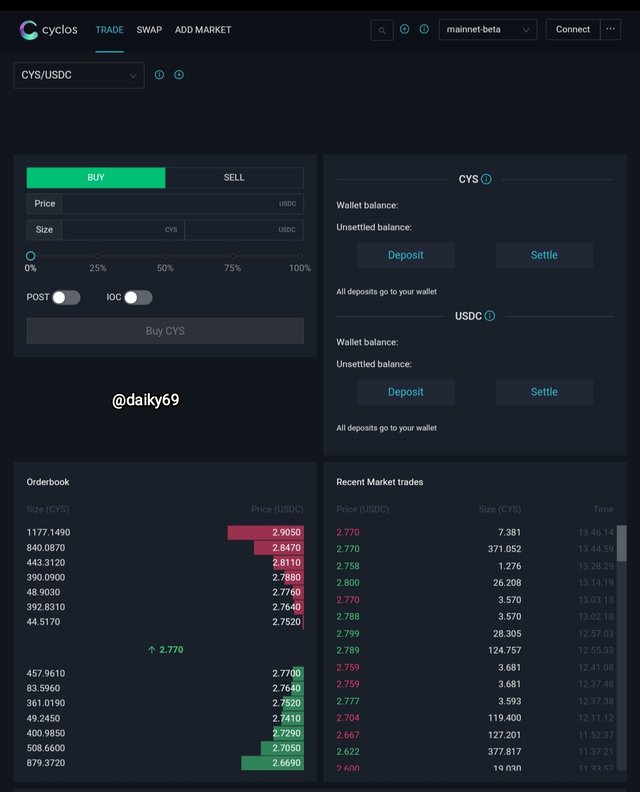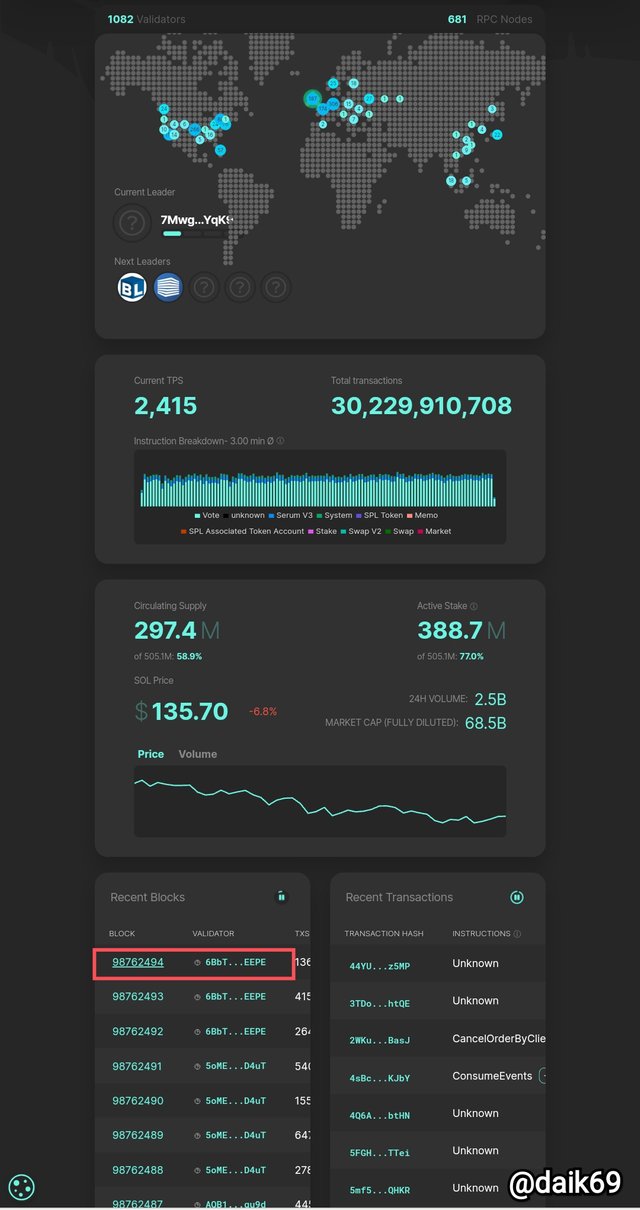Solana Blockchain - Crypto Academy / S4W4 - Homework post for pelon53

This is the task from professor @pelon53, I will work on it as best I can.

1.- Explain in detail Solana's PoH

Solana Blockchain is one of the many crypto projects that have speed in conducting transactions, but Solana is still at the forefront and is also different from other blockchains. Despite having the same idea and goal to become the blockchain with the fastest and most scalable network in the world, the way Solana Blockchain works is different from the others.
Solana Blockchain uses the latest technology in carrying out its operations to support their main goal, which is faster and more scalable. Solana Blockchain uses a new consensus called Proof-of-History, Proof-of-History consensus can create a record of transactions so that we can prove a transaction occurred at a certain time. Solana Blockchain uses Verifiable Delay Function algorithm a high frequency. After that, this algorithm requires a number of steps that need to be done to be able to evaluate.
Each transaction or event that has been evaluated will be assigned a unique hash with a publicly verifiable and effective amount. Thus, it will allow us to know when each transaction or event occurred on the Solana network, Proof-of-History can also function like a cryptographic timestamp. Each node also has a cryptographic clock that can track network time and transaction sequences. With all these ways of working, the Solana Blockchain network allows for high throughput as well as higher efficiency.
Solana's PoH consensus creates extremely high efficiencies and higher output rates in its network. The existence of a transaction history record allows the system to more easily track transactions and sequences of events.

Proof of History works by running a hash function (SHA256) continuously and the output of that function becomes the input of the next function to form a hash chain. PoH will add vital data before consensus to help optimize consistency in reading data because sequences and timestamps can be validated without continuing to monitor directly and without interacting directly with each node, besides PoH will also synchronize PoH with each other automatically.
More details PoH works to create A long unbroken chain through the hashing process. This will result in transactions sequentially and clearly being verified, then added to a block by the selected validator without the need for conventional timestamps. After that, the hashing will work by taking some time to complete, then the validator can verify the length of time it took for the elapsed hash very easily.
PoH also has a function for the BFT Tower as a his cryptographic clock. This allows consensus to be achieved without the need for message transfer fees and high transaction latency. The Tower BFT itself simplifies the performance of the PoH consensus.

2.- Describe at least 2 use cases of Solana

Although there are many projects built on the Solana network, I chose cyclos and orcas to describe in this assignment.
1. Cyclos

As you can see in the screenshot above, cyclos is a market provider of concentrated liquidity in Solana. We can swap in cyclos and also function as a decentralized crypto exchange (DEX), with Automated Market Makers (AMM) mechanism. This platform also falls under the DeFi category.

On the Cyclos platform we can trade like on the CEX platform with book orders but with a DEX mechanism and also do Swap if you want to be fast, there are many crypto coins available on the Cyclos platform to exchange, there are also pools if you want to dive into it.
Cyclos also has a native token under the name CYS, this token also uses smart contracts from the Solana blockchain. For more detailed information about CYS, see CoinMarketCap/CYS, or SOLSCAN/Cyclos.
2. Orca

Then there is the Orca project which is built on the Solana Blockchain network, Orca is a DEX platform with fairly easy usability and very low fees. To use this platform we are required to connect the Sollet wallet, or any other wallet of our choice. Not only DEX, the Orca platform is also included in the AMM, DeFi, DAO, and Yield Farming categories.

We can swap on the orca platform, there are at least 35 different cryptos and we can exchange all of those coins. In addition, we can also stake on the Orca platform and jump into the pools. This platform is quite simple and easy to operate.

Orca also has a native token that has the same name as the platform name, namely the orca token. This token is also created with smart contracts from the Solana Blockchain, so it has excellent speed and scalability when making transactions. To see more information about the orca token, you can access it at CoinMarketCap/Orca, or SOLSCAN/Orca.

3.- Explain SOLA token in detail


Sola token is a native token from the https://solatoken.net/ platform, it is a DEX platform with various features being designed. Sola token is the governance token of the platform, by holding the sola token, we can participate in every decision made by the solatoken.net platform.
There are 1,893 SOLA Token holders currently, the token that can only be traded on the DEX Solatoken Application is not listed on other Exchanges, even just information is difficult to find because it is not yet registered on Coinmarketcap, Sola tokens can only be traded with the SOLA / USDC pair.
This is brief information about the Sola token that I collected from Coiningecko and Solscan when I wrote this post, here are the data:
- Rank: 1810
- Circulating Supply: 27.153.077 Sola
- Max Supply: 27.153.077 Sola
- Price: US$0,058806
- Market Cap: US$1.664.565
- Transaction volume in 24h: US$54.261

4.- When did Solana Blockchain see its operations disrupted? Why?

The Solana Blockchain network experienced a disruption severe enough to make the entire blockchain network completely shut down for almost a day, this happened on September 14. All projects that use smart contracts from Solana also experienced the same thing due to the death of the main network.
According to the information provided by the Solana team, the death of the Solana Blockchain network was due to the large number of transaction flows occurring at the same time, causing the Solana network to be completely paralyzed. The team suspect this is caused by bots that make solana transactions go up to 400,000 per second.

400,000 transactions per second is the number of transactions that exceeds Solana's capacity, so far the transactions that Solana can accommodate are around 65,000 transactions per second. So that there is a waste of resources on the blockchain server to process the transaction which ultimately results in a denial of service on the Solana Blockchain network.
Based on the explanation from Anatoly Yakovenko, the bot that flooded the transaction is one of Solana's main projects, namely Raydium (RAY).

People flocked to use bots in making transactions to participate in the issuance of the Grape Protocol (GRAPE). Which in the end caused a flood of transactions on the Solana network so that it was difficult for validators to handle it, this is what caused the Solana Blockchain network to go down for a while (about 17 hours) on September 14.
Then the validators agreed to restart the blockchain so that it could return to normal. The validator worked hard to restart Solana's network, and in the end after going through a fairly tough restart process the validator managed to restart Solana's network in a matter of hours.
This is certainly the biggest question mark for some people, how is it possible for a blockchain to be restarted. Solana Blockchain claims to be a fully decentralized blockchain, by restarting the Blockchain what about the immutability of the transactions? This is the biggest question mark for me personally.

5.- Check the last block generated in Solana and make an approximate calculation how many blocks per second have been generated in Solana, taking into account from the initial block to the current block? Explain your answer and show a screenshot.


This is really amazing, when I accessed Solanabeach.io to see the last block of Solana Blockchain, I was amazed by how many blocks Solana Blockchain was able to produce in just seconds. After I investigated further, it turned out that Solana Blockchain was able to produce 1 block per 0.5 second based on the information provided by the Solana team. I had to dig into the information because it was impossible to wait and check every generated block because it was too fast, in a matter of seconds a new block was produced.

The last block I saw was #98762494, and there were around 1364 transactions processed in that block with a successful transaction rate of around 98.31% which means 1341 transactions were executed successfully. If we use Solscan.io, we can see a very clear timestamp for block #98762494, see image below.

However, something different happened to the genesis block from Solana Blockchain, there is no timestamp that we can get in the genesis block.

Now let's calculate how many blocks the Solana Blockchain generates per second, hourly, per day, and per year. As information provided by Team Solana that the Solana Blockchain Network is capable of producing 1 block per 0.5s.
The current block is 98762494, if we multiply by 0.5 (0.5x98762494) then the result is 49381247s, now let's check from those seconds to years.

Then the result is 1.5658690703, this tells us that the time spent to generate the block is currently 1.5 years, although to be precise 18 months because Solana Blockchain started operating in March 2020. Based on the results of this excavation, we can conclude that Solana Blockchain is capable of producing 1 block every 0.5s.
If we multiply manually, the results are also not much different. 1 minute 120 blocks, 120x60= 7,200 in an hour 7,200 blocks are produced, now we multiply one day 7,200x24= 172,800 blocks that were successfully produced. For one month, 172,800x30= 5,184,000 blocks, 5,184,000x 18 months then the result is 93,312,000, and this is not much different from the current block.
- 1 blocks / Per 0.5 second
- 120 blocks / Per minute
- 7.200 blocks / Per hour
- 172.800 blocks / per 24 hours
- 5.184.000 blocks / per month
- 62.208.000 blocks / per year
Note» This is just a multiplication alone, the results will certainly have a slight difference.

Conclusion

Solana Blockchain is a very good and fastest blockchain in the world, the developers and the team of Questions were able to develop a blockchain that is very unique and different from the others. Even so, the name of a system or machine certainly has its drawbacks, as happened with the Solana Blockchain.
This certainly shows us that nothing is perfect, each has its advantages and disadvantages, we just need to enjoy it.
Final words, I want to say a thousand thanks to the @pelon53 process who has taught us new knowledge and raised a very interesting theme to learn. Thanks for him.
Wate ta kaloen post droe neuh hawa sang lon ikot lom 😆👍
Hahaha long hawa kuh lage ata droneuh na mudah. Ji vote beukah2
Ka ji tron harga, han troh le proxy, Uroe nyoe ubit that persen . . . 😅
Suwah lon tamah delegasi sang. . .